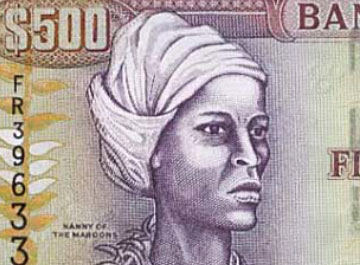Nanny circa 1685 — circa 1750

Nanny of the Maroons is an iconic figure in Jamaican history whose legacy has been celebrated in poems, portraits, and currency. Much of what is known about Nanny is the product of historical documents, historical memory, and folklore which, taken together, provide a sketch of this remarkable woman’s life.
Much of Nanny’s early life is unknown, including her birthplace. What is certain, however, is that she and other enslaved people sought refuge from a brutal slave society in the mountains of Jamaica, where together they established a maroon community. In 1720, Nanny had become the leader of a maroon settlement, Nanny Town, located in the Blue Mountain region. At the same time that Nanny headed this community, her contemporaries—Cudjoe, Accompong, Cuffee, and Quaco—led other maroon communities in Jamaica, but the nature of her relationship to them is not known.
Nanny trained her maroon warriors in the art of guerilla warfare. It is also said that she was a great obeah woman and worked magic to protect her warriors from their British enemies. The British fought Nanny and her maroon troops from 1728 to 1734. In 1734, British commander Stoddard destroyed Nanny Town and claimed to have killed all of the maroons residing there. In fact, Stoddard had not destroyed the maroons, nor did he kill Nanny. She and some of the survivors took refuge, it is believed, near the Rio Grande in Jamaica.
In 1739, another maroon leader, Cudjoe, signed a peace treaty with the British. Later, as a result of that treaty, Nanny and her maroons were granted five hundred acres of land upon which to settle. The settlement that emerged on this land was dubbed New Nanny Town.
Nanny likely died about 1750. Though the details of her life are still shrouded in mystery, Nanny’s legacy is strong. She remains a symbol of resistance and power in Jamaican history.







